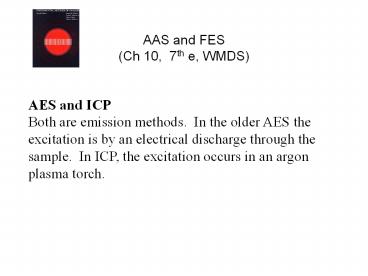AAS and FES (Ch 10, 7th e, WMDS) - PowerPoint PPT Presentation
1 / 16
Title:
AAS and FES (Ch 10, 7th e, WMDS)
Description:
... currents may be used for the excitation. ... both emission lines and molecular spectra. ... Most of the sample drains away from the chamber, the rest is ... – PowerPoint PPT presentation
Number of Views:88
Avg rating:3.0/5.0
Title: AAS and FES (Ch 10, 7th e, WMDS)
1
AAS and FES(Ch 10, 7th e, WMDS)
AES and ICPBoth are emission methods. In the
older AES the excitation is by an electrical
discharge through the sample. In ICP, the
excitation occurs in an argon plasma torch.
2
AAS and FES(Ch 10, 7th e, WMDS)
AES Lets discuss AES first. Both AC and DC
currents may be used for the excitation. The
sample may be positioned in any of the electrode
configurations shown in Figure 10.1. Electrodes
are generally made of high purity graphite which
can be machined to the desired shapes and
exhibits very few emission lines.
3
AAS and FES(Ch 10, 7th e, WMDS)
AES The DC arc produces both emission lines and
molecular spectra. The electrodes are heated by
the DC current to high temperatures so the
spectra include significant background radiation.
DC arc is best suited to qualitative or
semiquantitative analyses. The use of an
internal standard is valuable in minimizing the
effects of arc instability and the sample matrix.
4
AAS and FES(Ch 10, 7th e, WMDS)
5
AAS and FES(Ch 10, 7th e, WMDS)
6
AAS and FES(Ch 10, 7th e, WMDS)
AES The AC arc offers the advantages of lower
operating temperatures and increased precision,
but generally are less sensitive.
7
AAS and FES(Ch 10, 7th e, WMDS)
MicroprobeThe use of a laser to focus on a very
small portion of the sample and examine the
emission lines produced. Because the cross
sectional area of the sample is so small due to
the properties of the laser, this method is
essentially nondestructive, because the cross
section has a diameter of 50?m.
8
AAS and FES(Ch 10, 7th e, WMDS)
ICP - induced coupled plasma. A more
recent development in emission spectroscopy is
that of induced coupled plasma (ICP). A plasma
consists of a very hot mixture of partially
ionized gas with a relatively high concentration
of positive and negative ions. In ICP this plasma
is generally produced with a flowing stream of
argon gas, so the ions are Arn species and
electrons. The flowing mixture of ions and
electrons are 'ignited' by a spark from a Tesla
coil and it is the resulting collisions between
ions and un-ionized gas to produce the high
temperatures (as high as 10,000K).
9
AAS and FES(Ch 10, 7th e, WMDS)
Flame Profile of an ICP torch
10
AAS and FES(Ch 10, 7th e, WMDS)
ICP A distinct advantage of this method over FES
is that the greater energy allows the excitation
to higher levels and increases the population of
excited atoms. The latter increases the intensity
of the emitted lines, allowing for increased
sensitivity.
11
AAS and FES(Ch 10, 7th e, WMDS)
ICP. The purpose of the spray chamber is to
make sure that only droplets in a narrow size
range make it through into the plasma. Most of
the sample drains away from the chamber, the rest
is carried into the plasma and instantly excited
by the high temperatures (5000-10,000 K)
12
AAS and FES(Ch 10, 7th e, WMDS)
ICP Within the plasma most atoms become ionized
with 99 efficiency. Either ICP-optical emission
spectrometry (ICP-OES) or ICP mass spectrometry
(ICP-MS) may be used to analyze samples. ICP-OES
uses UV and visible spectrometry to image the
plasma at the exact wavelength of ionic
excitation of the element of interest. This is a
well-established technique.
13
AAS and FES(Ch 10, 7th e, WMDS)
14
AAS and FES(Ch 10, 7th e, WMDS)
ICP ICP-MS is a more recent addition to ICP
technology where a mass spectrometer is used to
separate and analyze the atoms produced in the
plasma. A portion of the ionized gas from the
tail of the ICP torch is introduced into the
vacuum system of a MS.
15
AAS and FES(Ch 10, 7th e, WMDS)
Introduction of the ICP ionized gas into the
vacuum of the MS
16
AAS and FES(Ch 10, 7th e, WMDS)








![[PDF] Ingle's Endodontics 7th Edition Kindle PowerPoint PPT Presentation](https://s3.amazonaws.com/images.powershow.com/10079845.th0.jpg?_=202407171212)


![[PDF] Study Guide for Gould's Pathophysiology for the Health Professions 7th Edition Free PowerPoint PPT Presentation](https://s3.amazonaws.com/images.powershow.com/10101157.th0.jpg?_=202408160911)

![[PDF] Oral Pathology 7th Edition Free PowerPoint PPT Presentation](https://s3.amazonaws.com/images.powershow.com/10084208.th0.jpg?_=202407230912)

![[PDF] Handbook of Local Anesthesia 7th Edition Android PowerPoint PPT Presentation](https://s3.amazonaws.com/images.powershow.com/10078606.th0.jpg?_=20240715121)

![[PDF] Essentials of Dental Assisting 7th Edition Android PowerPoint PPT Presentation](https://s3.amazonaws.com/images.powershow.com/10078631.th0.jpg?_=20240715015)


![[PDF] Roberts and Hedges’ Clinical Procedures in Emergency Medicine and Acute Care 7th Edition Ipad PowerPoint PPT Presentation](https://s3.amazonaws.com/images.powershow.com/10096749.th0.jpg?_=20240812012)
![[PDF] Health Insurance Today 7th Edition Android PowerPoint PPT Presentation](https://s3.amazonaws.com/images.powershow.com/10078630.th0.jpg?_=202407190110)




![[PDF] Foundations of Mental Health Care 7th Edition Ipad PowerPoint PPT Presentation](https://s3.amazonaws.com/images.powershow.com/10076358.th0.jpg?_=20240710093)




![[PDF] Health Assessment for Nursing Practice 7th Edition Android PowerPoint PPT Presentation](https://s3.amazonaws.com/images.powershow.com/10078624.th0.jpg?_=202407151211)